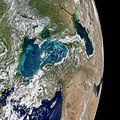Fichièr:Turquoise Swirls in the Black Sea.jpg

Talha d'aquesta previsualizacion: 600 × 600 pixèls. Autras resolucions : 240 × 240 pixèls | 480 × 480 pixèls | 768 × 768 pixèls | 1 024 × 1 024 pixèls | 2 048 × 2 048 pixèls | 7 000 × 7 000 pixèls.
Fichièr d'origina (7 000 × 7 000 pixèl, talha del fichièr: 16,71 Mo, tipe MIME: image/jpeg)
Istoric del fichièr
Clicar sus una data e una ora per veire lo fichièr tal coma èra a aqueste moment
| Data e ora | Miniatura | Dimensions | Utilizaire | Comentari | |
|---|---|---|---|---|---|
| actual | 12 junh de 2017 a 08.55 |  | 7 000×7 000 (16,71 Mo) | Originalwana | {{Information |Description ={{en|1=Most summers, jewel-toned hues appear in the Black Sea. The turquoise swirls are not the brushstrokes of a painting; they indicate the presence of phytoplankton, which trace the flow of water currents and eddies. O... |
Paginas que contenon lo fichièr
La pagina çaijós compòrta aqueste imatge :
Usatge global del fichièr
Los autres wikis seguents utilizan aqueste imatge :
- Utilizacion sus ar.wikipedia.org
- بوابة:محتوى متميز
- ويكيبيديا:صور مختارة
- ويكيبيديا:صور مختارة/الفضاء والكون
- ويكيبيديا:صور مختارة/الفضاء والكون/نظرة إلى الخلف
- بوابة:محتوى متميز/محتويات
- بوابة:محتوى متميز/محتويات/صور مختارة
- بوابة:محتوى متميز/الرئيسية
- علوم الأرض ناسا
- ويكيبيديا:يوم ويكيبيديا العربية التاسع عشر
- مستخدم:أيوب/يوم ويكيبيديا العربية التاسع عشر
- ويكيبيديا:يوم ويكيبيديا العربية التاسع عشر/تنفيذ الأهداف
- ويكيبيديا:ترشيحات الصور المختارة/البحر الأسود
- ويكيبيديا:صورة اليوم المختارة/أغسطس 2023
- قالب:صورة اليوم المختارة/2023-08-31
- Utilizacion sus be-tarask.wikipedia.org
- Utilizacion sus bn.wikibooks.org
- Utilizacion sus crh.wikipedia.org
- Utilizacion sus cs.wikipedia.org
- Utilizacion sus cv.wikipedia.org
- Utilizacion sus dz.wikipedia.org
- Utilizacion sus en.wikipedia.org
- Utilizacion sus fa.wikipedia.org
- Utilizacion sus fa.wikibooks.org
- Utilizacion sus frp.wikipedia.org
- Utilizacion sus fr.wikipedia.org
- Utilizacion sus gl.wikipedia.org
- Utilizacion sus he.wikipedia.org
- Utilizacion sus hu.wikipedia.org
- Utilizacion sus hy.wikipedia.org
- Utilizacion sus hy.wikibooks.org
- Utilizacion sus it.wiktionary.org
- Utilizacion sus ka.wikipedia.org
- Utilizacion sus ko.wikipedia.org
Veire l'utilizacion globala d'aqueste fichièr.




